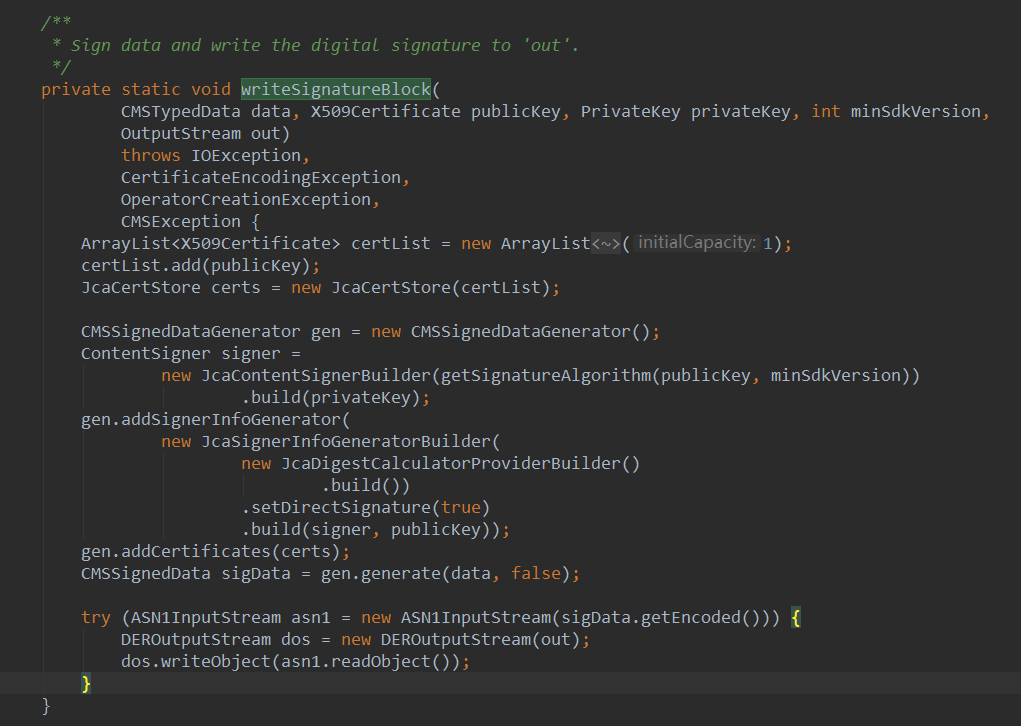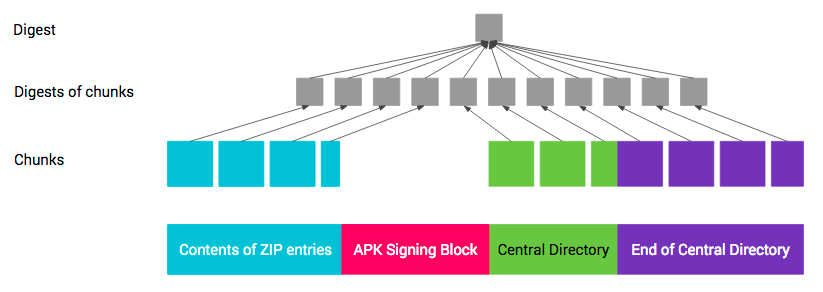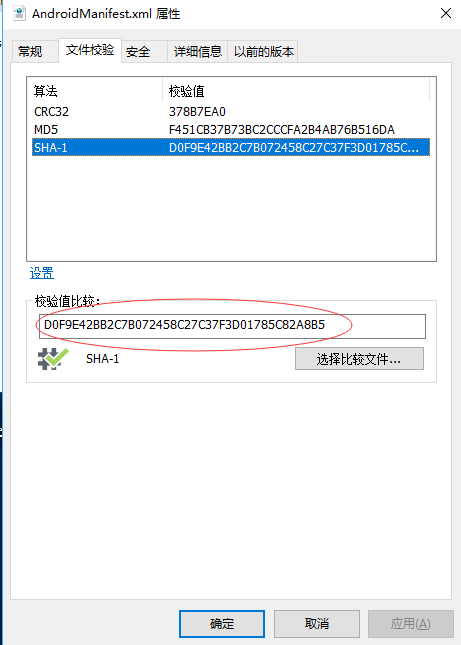也谈Android签名机制
1. 前言
关于Android的签名机制,在一个月前就看过了,当时还写了下流程,感觉没有太大的技术含量就没有记录。最近在看APK安装过程,突然又想起安装过程包含了APK的验证,关于APK的验证无非就是签名的逆过程。但是发现自己对签名过程好像模糊了很多,遂决定记录下签名过程。
2. 关于签名
Android的签名现在分为两个版本:v1和v2,因为v1版本签名过程的缺陷,造成了APK可能被攻击。
v1签名:签名和摘要文件为APK解压后的META-INF文件夹下的*.MF、*.SF、*.RSA文件,其签名过程需要对文件进行解压并且计算每个文件的摘要。
v2签名:签名信息存储在ZIP文件格式中。7.0以上支持,7.0以下不支持,只能采用v1签名。

3. v1签名源码
我用到的源码都是在在线源码网站上下载的,这里用到了SignApk.java文件。
我们都知道如果使用命令行签名的话,都是执行的main方法:
public static void main(String[] args) {
// 对输入参数的解析和验证
......
boolean signWholeFile = false;
String providerClass = null;
int alignment = 4;
int minSdkVersion = 0;
boolean signUsingApkSignatureSchemeV2 = true;
int argstart = 0;
// 对输入参数的解析和验证
......
loadProviderIfNecessary(providerClass);
String inputFilename = args[args.length - 2];
String outputFilename = args[args.length - 1];
JarFile inputJar = null;
FileOutputStream outputFile = null;
int hashes = 0;
try {
// 公钥文件
File firstPublicKeyFile = new File(args[argstart + 0]);
X509Certificate[] publicKey = new X509Certificate[numKeys];
......
long timestamp = 1230768000000L;
timestamp -= TimeZone.getDefault().getOffset(timestamp);
// 私钥文件
PrivateKey[] privateKey = new PrivateKey[numKeys];
for (int i = 0; i < numKeys; ++i) {
int argNum = argstart + i * 2 + 1;
privateKey[i] = readPrivateKey(new File(args[argNum]));
}
// 输入的文件
inputJar = new JarFile(new File(inputFilename), false); // Don't verify.
// 输出文件
outputFile = new FileOutputStream(outputFilename);
// 直接对整个文件签名,这里不看
if (signWholeFile) {
SignApk.signWholeFile(inputJar, firstPublicKeyFile,
publicKey[0], privateKey[0],
timestamp, minSdkVersion,
outputFile);
} else {
ByteArrayOutputStream v1SignedApkBuf = new ByteArrayOutputStream();
JarOutputStream outputJar = new JarOutputStream(v1SignedApkBuf);
outputJar.setLevel(9);
// 1. 生成.MF信息内容
Manifest manifest = addDigestsToManifest(inputJar, hashes);
copyFiles(manifest, inputJar, outputJar, timestamp, alignment);
// 2. 对文件签名,生成.SF文件内容并且签名
signFile(
manifest,
publicKey, privateKey,
timestamp, minSdkVersion, signUsingApkSignatureSchemeV2,
outputJar);
outputJar.close();
ByteBuffer v1SignedApk = ByteBuffer.wrap(v1SignedApkBuf.toByteArray());
v1SignedApkBuf.reset();
ByteBuffer[] outputChunks;
// 使用v2签名
if (signUsingApkSignatureSchemeV2) {
// Additionally sign the APK using the APK Signature Scheme v2.
ByteBuffer apkContents = v1SignedApk;
List<ApkSignerV2.SignerConfig> signerConfigs =
createV2SignerConfigs(
privateKey,
publicKey,
new String[]{APK_SIG_SCHEME_V2_DIGEST_ALGORITHM});
outputChunks = ApkSignerV2.sign(apkContents, signerConfigs);
} else {
// Output the JAR-signed APK as is.
outputChunks = new ByteBuffer[]{v1SignedApk};
}
// This assumes outputChunks are array-backed. To avoid this assumption, the
// code could be rewritten to use FileChannel.
for (ByteBuffer outputChunk : outputChunks) {
outputFile.write(
outputChunk.array(),
outputChunk.arrayOffset() + outputChunk.position(),
outputChunk.remaining());
outputChunk.position(outputChunk.limit());
}
outputFile.close();
outputFile = null;
return;
}
}
......
}
v1签名过程很简单,一共分为了三个部分:
- 对非目录文件以及过滤文件进行摘要,存储在MANIFEST.MF文件中。
- 对MANIFEST.MF文件的进行摘要以及对MANIFEST.MF文件的每个条目内容进行摘要,存储在CERT.SF文件中。
-
使用指定的私钥对CERT.SF文件计算签名,然后将签名以及包含公钥信息的数字证书写入 CERT.RSA。
这三个文件也就是我们APK解压后META-INF目录下的文件:
签名和摘要文件
3.1 .MF文件内容生成
上面已经说了,MANIFEST.MF的内容是通过addDigestsToManifest方法生成的,代码如下:
/**
* 添加对所有不是目录文件的摘要(SHA1或SHA256)
*/
private static Manifest addDigestsToManifest(JarFile jar, int hashes)
throws IOException, GeneralSecurityException {
// 最上面那部分内容
Manifest input = jar.getManifest();
Manifest output = new Manifest();
Attributes main = output.getMainAttributes();
if (input != null) {
main.putAll(input.getMainAttributes());
} else {
main.putValue("Manifest-Version", "1.0");
main.putValue("Created-By", "1.0 (Android SignApk)");
}
// 根据输入来选择摘要算法
MessageDigest md_sha1 = null;
MessageDigest md_sha256 = null;
if ((hashes & USE_SHA1) != 0) {
md_sha1 = MessageDigest.getInstance("SHA1");
}
if ((hashes & USE_SHA256) != 0) {
md_sha256 = MessageDigest.getInstance("SHA256");
}
byte[] buffer = new byte[4096];
int num;
TreeMap<String, JarEntry> byName = new TreeMap<String, JarEntry>();
// 把apk文件所有条目添加到treemap中
for (Enumeration<JarEntry> e = jar.entries(); e.hasMoreElements(); ) {
JarEntry entry = e.nextElement();
byName.put(entry.getName(), entry);
}
// 遍历
for (JarEntry entry : byName.values()) {
String name = entry.getName();
// 如果不是目录并且不是特定的文件 attern.compile("^(META-INF/((.*)[.](SF|RSA|DSA|EC)|com/android/otacert))|(" +
// Pattern.quote(JarFile.MANIFEST_NAME) + ")$");
if (!entry.isDirectory() &&
(stripPattern == null || !stripPattern.matcher(name).matches())) {
InputStream data = jar.getInputStream(entry);
while ((num = data.read(buffer)) > 0) {
if (md_sha1 != null) md_sha1.update(buffer, 0, num);
if (md_sha256 != null) md_sha256.update(buffer, 0, num);
}
Attributes attr = null;
if (input != null) attr = input.getAttributes(name);
attr = attr != null ? new Attributes(attr) : new Attributes();
for (Iterator<Object> i = attr.keySet().iterator(); i.hasNext(); ) {
Object key = i.next();
if (!(key instanceof Attributes.Name)) {
continue;
}
String attributeNameLowerCase =
((Attributes.Name) key).toString().toLowerCase(Locale.US);
if (attributeNameLowerCase.endsWith("-digest")) {
i.remove();
}
}
// 计算摘要 并且使用base64进行encode
// Add SHA-1 digest if requested
if (md_sha1 != null) {
attr.putValue("SHA1-Digest",
new String(Base64.encode(md_sha1.digest()), "ASCII"));
}
if (md_sha256 != null) {
attr.putValue("SHA-256-Digest",
new String(Base64.encode(md_sha256.digest()), "ASCII"));
}
output.getEntries().put(name, attr);
}
}
return output;
}
其过程分为三步:
-
添加最上面内容信息
上部分内容 - 将APK内容遍历,寻找不为目录并且没有被过滤的文件,对其进行摘要计算。
- 将摘要信息写入。
验证一下:
AndroidManifest.xml文件对应的摘要
文件摘要
这么看这两个值还不相同呢,但是我们仔细看下代码new String(Base64.encode(md_sha1.digest()), "ASCII")这里将摘要内容进行Base64编码后又将其转成String了,我们可以看下:
byte[] bytes = {(byte) 0xD0, (byte) 0xF9, (byte) 0xE4, 0x2B, (byte) 0xB2, (byte) 0xC7, (byte) 0xB0, 0x72, 0x45, (byte) 0x8C, 0x27, (byte) 0xC3, 0x7F, 0x3D, 0x01, 0x78, 0x5C, (byte) 0x82, (byte) 0xA8, (byte) 0xB5};
String ascii = new String(Base64.getEncoder().encode(bytes), "ASCII");
System.out.println(ascii);
输出内容:

简化的代码如下:
private static Manifest addDigestsToManifest(JarFile jarFile) throws IOException, NoSuchAlgorithmException {
Manifest input = jarFile.getManifest();
Manifest output = new Manifest();
Attributes main = output.getMainAttributes();
if (input != null) {
main.putAll(input.getMainAttributes());
} else {
main.putValue("Manifest-Version", "1.0");
main.putValue("Created-By", "1.0 (Android SignApk)");
}
MessageDigest sha1 = MessageDigest.getInstance("SHA1");
TreeMap<String, JarEntry> byName = new TreeMap<>();
Enumeration<JarEntry> entries = jarFile.entries();
while (entries.hasMoreElements()) {
JarEntry jarEntry = entries.nextElement();
byName.put(jarEntry.getName(), jarEntry);
}
byte[] data = new byte[4096];
int num = 0;
for (JarEntry jarEntry : byName.values()) {
if (!jarEntry.isDirectory()) {
InputStream inputStream = jarFile.getInputStream(jarEntry);
while ((num = inputStream.read(data)) > 0) {
sha1.update(data, 0, num);
}
Attributes attributes = null;
if (input != null) {
attributes = input.getAttributes(jarEntry.getName());
}
if (attributes == null) {
attributes = new Attributes();
}
attributes.putValue("SHA1-Digest", new String(Base64.getEncoder().encode(sha1.digest()), "ASCII"));
output.getEntries().put(jarEntry.getName(), attributes);
}
}
output.write(new FileOutputStream("C:\\Users\\nick\\Desktop\\MANIFEST.MF"));
return output;
}
3.2 .SF文件内容生成
.SF文件内容是需要依赖.MF文件内容:
/**
* Write a .SF file with a digest of the specified manifest.
* 写入.sf文件
*/
private static void writeSignatureFile(Manifest manifest, OutputStream out,
int hash, boolean additionallySignedUsingAnApkSignatureScheme)
throws IOException, GeneralSecurityException {
Manifest sf = new Manifest();
Attributes main = sf.getMainAttributes();
// 添加内容
main.putValue("Signature-Version", "1.0");
main.putValue("Created-By", "1.0 (Android SignApk)");
// v2签名 添加
if (additionallySignedUsingAnApkSignatureScheme) {
main.putValue(
ApkSignerV2.SF_ATTRIBUTE_ANDROID_APK_SIGNED_NAME,
ApkSignerV2.SF_ATTRIBUTE_ANDROID_APK_SIGNED_VALUE);
}
MessageDigest md = MessageDigest.getInstance(
hash == USE_SHA256 ? "SHA256" : "SHA1");
PrintStream print = new PrintStream(
new DigestOutputStream(new ByteArrayOutputStream(), md),
true, "UTF-8");
manifest.write(print);
print.flush();
main.putValue(hash == USE_SHA256 ? "SHA-256-Digest-Manifest" : "SHA1-Digest-Manifest",
new String(Base64.encode(md.digest()), "ASCII"));
// 这段代码将上面的.MF的内容以
// Name: res/layout/fb_community_manage_activity.xml\r\nSHA1-Digest: 2JZzBj3bimvi5pwxQZH4LlJJTcg=\r\n\r\n
// 获取其摘要,并且按照相同的格式存储
Map<String, Attributes> entries = manifest.getEntries();
for (Map.Entry<String, Attributes> entry : entries.entrySet()) {
// Digest of the manifest stanza for this entry.
print.print("Name: " + entry.getKey() + "\r\n");
for (Map.Entry<Object, Object> att : entry.getValue().entrySet()) {
print.print(att.getKey() + ": " + att.getValue() + "\r\n");
}
print.print("\r\n");
print.flush();
Attributes sfAttr = new Attributes();
sfAttr.putValue(hash == USE_SHA256 ? "SHA-256-Digest" : "SHA1-Digest",
new String(Base64.encode(md.digest()), "ASCII"));
sf.getEntries().put(entry.getKey(), sfAttr);
}
CountOutputStream cout = new CountOutputStream(out);
sf.write(cout);
if ((cout.size() % 1024) == 0) {
cout.write('\r');
cout.write('\n');
}
}
主要两个步骤:
- 计算.MF整个文件内容摘要,存放在上面的位置。
- 计算.MF每一项内容,将其拼接成
Name: res/layout/fb_community_manage_activity.xml\r\nSHA1-Digest: 2JZzBj3bimvi5pwxQZH4LlJJTcg=\r\n\r\n格式并计算这段内容的摘要并以相同格式保存
验证:
String s = "Name: AndroidManifest.xml\r\nSHA1-Digest: 0PnkK7LHsHJFjCfDfz0BeFyCqLU=\r\n\r\n";
MessageDigest messageDigest = MessageDigest.getInstance("SHA1");
messageDigest.update(s.getBytes());
byte[] digest = messageDigest.digest();
System.out.println(new String(Base64.getEncoder().encode(digest), "ASCII"));
输出:


简化版:
private static void signFile(Manifest outPut) throws NoSuchAlgorithmException, IOException {
Manifest sf = new Manifest();
Attributes main = sf.getMainAttributes();
main.putValue("Signature-Version", "1.0");
main.putValue("Created-By", "1.0 (Android SignApk)");
MessageDigest messageDigest = MessageDigest.getInstance("SHA1");
PrintStream print = new PrintStream(
new DigestOutputStream(new ByteArrayOutputStream(), messageDigest),
true, "UTF-8");
outPut.write(print);
print.flush();
main.putValue("SHA1-Digest-Manifest",
new String(Base64.getEncoder().encode(messageDigest.digest()), "ASCII"));
Map<String, Attributes> entries = outPut.getEntries();
for (Map.Entry<String, Attributes> stringAttributesEntry : entries.entrySet()) {
print.print("Name: " + stringAttributesEntry.getKey() + "\r\n");
for (Map.Entry<Object, Object> att : stringAttributesEntry.getValue().entrySet()) {
print.print(att.getKey() + ": " + att.getValue() + "\r\n");
}
print.print("\r\n");
print.flush();
Attributes sfAttr = new Attributes();
sfAttr.putValue("SHA1-Digest",
new String(Base64.getEncoder().encode(messageDigest.digest()), "ASCII"));
sf.getEntries().put(stringAttributesEntry.getKey(), sfAttr);
}
sf.write(new FileOutputStream("C:\\Users\\nick\\Desktop\\CERT.SF"));
}
这里有个问题,.SF文件在老的APK(可能是使用v1签名?)中确实是由上面代码生成,但是我看最新的APK文件中.SF文件内容和.MF文件内容一致,猜想可能是v1和v2签名的原因,具体不详。
3.3 签名

上面我们得到了.SF文件的内容,通过私钥和公钥就可以对其获得签名信息,根据签名信息即可生成.RSA文件(没有验证过程)。
4.1 v2签名
先复制一下v1签名的漏洞:
1、安卓在4.4中引入了新的执行虚拟机ART,这个虚拟机经过重新的设计,实现了大量的优化,提高了应用的运行效率。与“Janus”有关的一个技术点是,ART允许运行一个raw dex,也就是一个纯粹的dex文件,不需要在外面包装一层zip。而ART的前任DALVIK虚拟机就要求dex必须包装在一个zip内部且名字是classes.dex才能运行。当然ART也支持运行包装在ZIP内部的dex文件,要区别文件是ZIP还是dex,就通过文件头的magic字段进行判断:ZIP文件的开头是‘PK’, 而dex文件的开头是’dex’.
2、ZIP文件的读取方式是通过在文件末尾定位central directory, 然后通过里面的索引定位到各个zip entry,每个entry解压之后都对应一个文件。
通过漏洞就可以知道系统在解压ZIP文件时根据其末尾来解压,但是执行的过程又根据其头部来执行,这样就可以通过注入新的dex在头部来实现攻击的目的。
v2签名官方文档,以下内容来自官方文档:
APK 签名方案 v2 是一种全文件签名方案,该方案能够发现对 APK 的受保护部分进行的所有更改,从而有助于加快验证速度并增强完整性保证。
使用 APK 签名方案 v2 进行签名时,会在 APK 文件中插入一个 APK 签名分块,该分块位于“ZIP 中央目录”部分之前并紧邻该部分。在“APK 签名分块”内,v2 签名和签名者身份信息会存储在APK 签名方案 v2 分块中。
![img_3b58623e45132444000f458058107d4b.png]() image.png
image.png
APK 签名分块
为了保持与当前 APK 格式向后兼容,v2 及更高版本的 APK 签名会存储在“APK 签名分块”内,该分块是为了支持 APK 签名方案 v2 而引入的一个新容器。在 APK 文件中,“APK 签名分块”位于“ZIP 中央目录”(位于文件末尾)之前并紧邻该部分。
该分块包含多个“ID-值”对,所采用的封装方式有助于更轻松地在 APK 中找到该分块。APK 的 v2 签名会存储为一个“ID-值”对,其中 ID 为 0x7109871a。
APK 签名方案 v2 分块
APK 由一个或多个签名者/身份签名,每个签名者/身份均由一个签名密钥来表示。该信息会以“APK 签名方案 v2 分块”的形式存储。对于每个签名者,都会存储以下信息:
(签名算法、摘要、签名)元组。摘要会存储起来,以便将签名验证和 APK 内容完整性检查拆开进行。
表示签名者身份的 X.509 证书链。
采用键值对形式的其他属性。
对于每位签名者,都会使用收到的列表中支持的签名来验证 APK。签名算法未知的签名会被忽略。如果遇到多个支持的签名,则由每个实现来选择使用哪个签名。这样一来,以后便能够以向后兼容的方式引入安全系数更高的签名方法。建议的方法是验证安全系数最高的签名。
v2与v1签名最大的区别就是v2修改了APK文件的内容,将其签名块放到了APK文件中(v2签名验证需要验证APK文件的这部分)。
签名块生成,这里代码用的时ApkSignerV2.java:
public static ByteBuffer[] sign(
ByteBuffer inputApk,
List<SignerConfig> signerConfigs)
throws ApkParseException, InvalidKeyException, SignatureException {
ByteBuffer originalInputApk = inputApk;
inputApk = originalInputApk.slice();
inputApk.order(ByteOrder.LITTLE_ENDIAN);
// 获取EoCD位置以及对ZIP文件的校验
int eocdOffset = ZipUtils.findZipEndOfCentralDirectoryRecord(inputApk);
......
inputApk.clear();
ByteBuffer beforeCentralDir = getByteBuffer(inputApk, centralDirOffset);
ByteBuffer centralDir = getByteBuffer(inputApk, eocdOffset - centralDirOffset);
byte[] eocdBytes = new byte[inputApk.remaining()];
inputApk.get(eocdBytes);
ByteBuffer eocd = ByteBuffer.wrap(eocdBytes);
eocd.order(inputApk.order());
Set<Integer> contentDigestAlgorithms = new HashSet<>();
for (SignerConfig signerConfig : signerConfigs) {
for (int signatureAlgorithm : signerConfig.signatureAlgorithms) {
contentDigestAlgorithms.add(
getSignatureAlgorithmContentDigestAlgorithm(signatureAlgorithm));
}
}
// Compute digests of APK contents.
Map<Integer, byte[]> contentDigests; // digest algorithm ID -> digest
try {
// 计算内容摘要
contentDigests =
computeContentDigests(
contentDigestAlgorithms,
new ByteBuffer[]{beforeCentralDir, centralDir, eocd});
} catch (DigestException e) {
throw new SignatureException("Failed to compute digests of APK", e);
}
// 生成签名块
ByteBuffer apkSigningBlock =
ByteBuffer.wrap(generateApkSigningBlock(signerConfigs, contentDigests));
centralDirOffset += apkSigningBlock.remaining();
eocd.clear();
ZipUtils.setZipEocdCentralDirectoryOffset(eocd, centralDirOffset);
originalInputApk.position(originalInputApk.limit());
beforeCentralDir.clear();
centralDir.clear();
eocd.clear();
// Insert APK Signing Block immediately before the ZIP Central Directory.
// 将内容重组
// 1. ZIP 条目的内容(从偏移量 0 处开始一直到“APK 签名分块”的起始位置)
// 2. APK 签名分块
// 3. ZIP 中央目录
// 4. ZIP 中央目录结尾
return new ByteBuffer[]{
beforeCentralDir,
apkSigningBlock,
centralDir,
eocd,
};
}
代码也不多,分为三步:
- 计算内容摘要。
- 对内容摘要进行签名,并生成签名块。
- 将签名块添加到原APK文件内容中。
4.1 计算内容摘要

第 1、3 和 4 部分的完整性通过其内容的一个或多个摘要来保护,这些摘要存储在 signed data 分块中,而这些分块则通过一个或多个签名来保护。
第 1、3 和 4 部分的摘要采用以下计算方式,类似于两级 Merkle 树。 每个部分都会被拆分成多个大小为 1 MB(220 个字节)的连续块。每个部分的最后一个块可能会短一些。每个块的摘要均通过字节 0xa5 的连接、块的长度(采用小端字节序的 uint32 值,以字节数计)和块的内容进行计算。顶级摘要通过字节 0x5a 的连接、块数(采用小端字节序的 uint32 值)以及块的摘要的连接(按照块在 APK 中显示的顺序)进行计算。摘要以分块方式计算,以便通过并行处理来加快计算速度。

生成代码如下:
/**
* 计算内容摘要
*
* @param digestAlgorithms 摘要算法
* @param contents 内容,这里三块
* @return 摘要Map
* @throws DigestException
*/
private static Map<Integer, byte[]> computeContentDigests(
Set<Integer> digestAlgorithms,
ByteBuffer[] contents) throws DigestException {
// 计算分成1M大小的数量
int chunkCount = 0;
for (ByteBuffer input : contents) {
chunkCount += getChunkCount(input.remaining(), CONTENT_DIGESTED_CHUNK_MAX_SIZE_BYTES);
}
// 设置摘要算法和摘要内容的Map
final Map<Integer, byte[]> digestsOfChunks = new HashMap<>(digestAlgorithms.size());
for (int digestAlgorithm : digestAlgorithms) {
int digestOutputSizeBytes = getContentDigestAlgorithmOutputSizeBytes(digestAlgorithm);
byte[] concatenationOfChunkCountAndChunkDigests =
new byte[5 + chunkCount * digestOutputSizeBytes];
concatenationOfChunkCountAndChunkDigests[0] = 0x5a;
setUnsignedInt32LittleEngian(
chunkCount, concatenationOfChunkCountAndChunkDigests, 1);
digestsOfChunks.put(digestAlgorithm, concatenationOfChunkCountAndChunkDigests);
}
int chunkIndex = 0;
byte[] chunkContentPrefix = new byte[5];
chunkContentPrefix[0] = (byte) 0xa5;
// Optimization opportunity: digests of chunks can be computed in parallel.
// 遍历内容
for (ByteBuffer input : contents) {
while (input.hasRemaining()) {
// 检查剩下的大小,取其和1M中小的哪个
int chunkSize =
Math.min(input.remaining(), CONTENT_DIGESTED_CHUNK_MAX_SIZE_BYTES);
final ByteBuffer chunk = getByteBuffer(input, chunkSize);
// 遍历摘要算法
for (int digestAlgorithm : digestAlgorithms) {
String jcaAlgorithmName =
getContentDigestAlgorithmJcaDigestAlgorithm(digestAlgorithm);
MessageDigest md;
try {
md = MessageDigest.getInstance(jcaAlgorithmName);
} catch (NoSuchAlgorithmException e) {
throw new DigestException(
jcaAlgorithmName + " MessageDigest not supported", e);
}
chunk.clear();
// 设置chunkContentPrefix为0xa5 + chunk.remaining()
setUnsignedInt32LittleEngian(chunk.remaining(), chunkContentPrefix, 1);
md.update(chunkContentPrefix);
md.update(chunk);
// 获得刚才保存的摘要算法对应的内容,0xa5+length,剩下全为0
byte[] concatenationOfChunkCountAndChunkDigests =
digestsOfChunks.get(digestAlgorithm);
// 期望的长度
int expectedDigestSizeBytes =
getContentDigestAlgorithmOutputSizeBytes(digestAlgorithm);
// 通过摘要算法后已经修改内容的长度
// 这里是将concatenationOfChunkCountAndChunkDigests内容更新为最新的摘要
int actualDigestSizeBytes =
md.digest(
concatenationOfChunkCountAndChunkDigests,
5 + chunkIndex * expectedDigestSizeBytes,
expectedDigestSizeBytes);
if (actualDigestSizeBytes != expectedDigestSizeBytes) {
throw new DigestException(
"Unexpected output size of " + md.getAlgorithm()
+ " digest: " + actualDigestSizeBytes);
}
}
chunkIndex++;
}
}
// 对concatenationOfChunkCountAndChunkDigests也就是我们每一块 0xa5 + chunkCount + (0xa5+length+内容的摘要)* chunkCount
Map<Integer, byte[]> result = new HashMap<>(digestAlgorithms.size());
for (Map.Entry<Integer, byte[]> entry : digestsOfChunks.entrySet()) {
int digestAlgorithm = entry.getKey();
byte[] concatenationOfChunkCountAndChunkDigests = entry.getValue();
String jcaAlgorithmName = getContentDigestAlgorithmJcaDigestAlgorithm(digestAlgorithm);
MessageDigest md;
try {
md = MessageDigest.getInstance(jcaAlgorithmName);
} catch (NoSuchAlgorithmException e) {
throw new DigestException(jcaAlgorithmName + " MessageDigest not supported", e);
}
result.put(digestAlgorithm, md.digest(concatenationOfChunkCountAndChunkDigests));
}
return result;
}
原理也简单,就是将其他部分内容分成1M大小的块,每个块的摘要均通过字节 0xa5 的连接、块的长度(采用小端字节序的 uint32 值,以字节数计)和块的内容进行摘要计算,将计算的结果放到以0xa5+length开头的数组中,最后将其进行摘要计算。
4.2 签名并且生成签名块
签名时对我们刚刚得到的摘要信息进行签名,签名的过程无非就是通过公钥和私钥进行签名计算,生成对应的签名信息(签名过程省略)。
签名块的生成:
/**
* 生成签名块
*
* @param apkSignatureSchemeV2Block apk签名
* @return
*/
private static byte[] generateApkSigningBlock(byte[] apkSignatureSchemeV2Block) {
// FORMAT:
// uint64: size (excluding this field)
// repeated ID-value pairs:
// uint64: size (excluding this field)
// uint32: ID
// (size - 4) bytes: value
// uint64: size (same as the one above)
// uint128: magic
int resultSize =
8 // size
+ 8 + 4 + apkSignatureSchemeV2Block.length // v2Block as ID-value pair
+ 8 // size
+ 16 // magic
;
ByteBuffer result = ByteBuffer.allocate(resultSize);
result.order(ByteOrder.LITTLE_ENDIAN);
long blockSizeFieldValue = resultSize - 8;
// size of block,以字节数(不含此字段)计 (uint64)
result.putLong(blockSizeFieldValue);
long pairSizeFieldValue = 4 + apkSignatureSchemeV2Block.length;
// size
result.putLong(pairSizeFieldValue);
// id 0x7109871a
result.putInt(APK_SIGNATURE_SCHEME_V2_BLOCK_ID);
// (size - 4) bytes签名块
result.put(apkSignatureSchemeV2Block);
// size of block,以字节数计 - 与第一个字段相同 (uint64)
result.putLong(blockSizeFieldValue);
// magic“APK 签名分块 42”(16 个字节)
result.put(APK_SIGNING_BLOCK_MAGIC);
return result.array();
}
签名块按照格式:
“APK 签名分块”的格式如下(所有数字字段均采用小端字节序):
size of block,以字节数(不含此字段)计 (uint64)
带 uint64 长度前缀的“ID-值”对序列:
ID (uint32)
value(可变长度:“ID-值”对的长度 - 4 个字节)
size of block,以字节数计 - 与第一个字段相同 (uint64)
magic“APK 签名分块 42”(16 个字节
生成。
4.3 生成签名后APK
生成签名后的APK很简单,我们已经获得了每块的内容:
1. Contents of ZIP entries
2. Central Directory
3. End of Central Directory
APK Signing Block
我们只需要将内容合并即可,合并顺序为:
1. Contents of ZIP entries
2. APK Signing Block
3. Central Directory
4. End of Central Directory
代码为:
// Insert APK Signing Block immediately before the ZIP Central Directory.
// 将内容重组
// 1. ZIP 条目的内容(从偏移量 0 处开始一直到“APK 签名分块”的起始位置)
// 2. APK 签名分块
// 3. ZIP 中央目录
// 4. ZIP 中央目录结尾
return new ByteBuffer[]{
beforeCentralDir,
apkSigningBlock,
centralDir,
eocd,
};
5 后记
啰里啰唆说了一大堆,终于将签名过程写完了。在Android APK安装时肯定会有对APK的签名信息验证的过程,这部分如果有时间去看Android APK安装流程时再仔细分析了。








